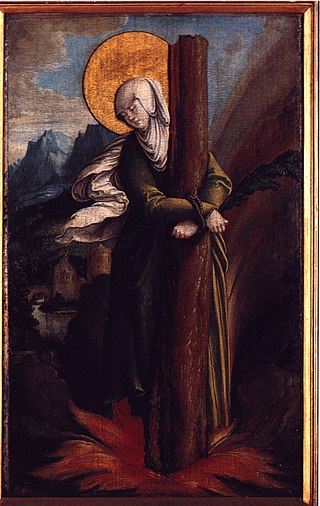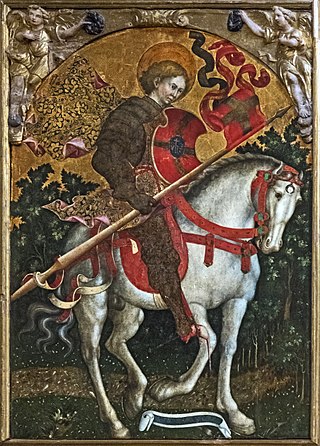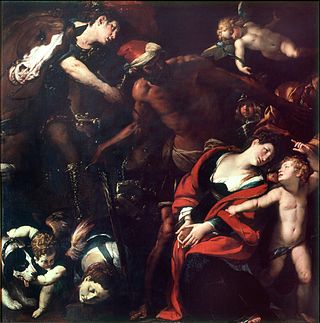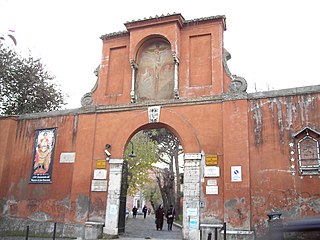Related Research Articles

Pope Callixtus I, also called Callistus I, was the bishop of Rome from c. 218 to his death c. 222 or 223. He lived during the reigns of the Roman emperors Elagabalus and Alexander Severus. Eusebius and the Liberian catalogue list his episcopate as having lasted five years (217–222). In 217, when Callixtus followed Zephyrinus as Bishop of Rome, he started to admit into the Church converts from sects or schisms. He was martyred for his Christian faith and is venerated as a saint by the Catholic Church.

Hippolytus of Rome was one of the most important second-third century Christian theologians, whose provenance, identity and corpus remain elusive to scholars and historians. Suggested communities include Rome, Palestine, Egypt, Anatolia and other regions of the Middle East. The best historians of literature in the ancient church, including Eusebius of Caesarea and Jerome, openly confess they cannot name where Hippolytus the biblical commentator and theologian served in leadership. They had read his works but did not possess evidence of his community. Photios I of Constantinople describes him in his Bibliotheca as a disciple of Irenaeus, who was said to be a disciple of Polycarp, and from the context of this passage it is supposed that he suggested that Hippolytus so styled himself. This assertion is doubtful. One older theory asserts he came into conflict with the popes of his time and seems to have headed a schismatic group as a rival to the bishop of Rome, thus becoming an antipope. In this view, he opposed the Roman Popes who softened the penitential system to accommodate the large number of new pagan converts. However, he was reconciled to the Church before he died as a martyr.

Saint Afra was martyred during the Diocletian persecution. Along with Saint Ulrich, she is a patron saint of Augsburg. Her feast day is August 7. Afra was dedicated to the service of the goddess Venus by her mother, Hilaria. Through his teachings, Bishop Narcissus converted Afra and her family to Christianity. When it was learned that Afra was a Christian, she was brought before Diocletian and ordered to sacrifice to the pagan gods. She refused and was condemned to death by fire.
Saints Theodora and Didymus are Christian saints whose legend is based on a 4th-century acta and the word of Saint Ambrose. The pair were martyred in the reigns of co-ruling Roman Emperors Diocletian and Maximianus. St. Theodora should not be confused with another St. Theodora of Alexandria commemorated on September 11.

Prisca was a young Roman woman allegedly tortured and executed for her Christian faith. The dates of her birth and death are unknown. She is revered as a saint and martyr in Eastern Orthodoxy, by the Catholic Church, and in the Anglican Communion.

August 12 - Eastern Orthodox liturgical calendar - August 14

The Martyrologium Hieronymianum or Martyrologium sancti Hieronymi is an ancient martyrology or list of Christian martyrs in calendar order, one of the most used and influential of the Middle Ages. It is the oldest surviving general or "universal" martyrology, and the precursor of all later Western martyrologies.

Euphemia, known as the All-praised in the Eastern Orthodox Church, was a virgin martyr, who died for her faith at Chalcedon in 303 AD.

Martinian and Processus were Christian martyrs of ancient Rome. Neither the years they lived nor the circumstances of their deaths are known. They are currently buried in St. Peter's Basilica in Rome.

Mark and Marcellian are martyrs venerated as saints by the Roman Catholic Church and the Eastern Orthodox Church. Their cult is sometimes associated with that of Saints Tranquillinus, Martia, Nicostratus, Zoe, Castulus and Tiburtius, though not in the official liturgical books of the Church, which mention only Mark and Marcellianus among the saints for 18 June. Their mention in the General Roman Calendar on that date from before the time of the Tridentine Calendar was removed in the 1969 revision, because nothing is known about them except their names, the fact of their martyrdom, and that they were buried on 18 June in the cemetery of Santa Balbina on the Via Ardeatina.
There are several saints named Rufus, of which the Roman Martyrology records ten; historical mention is made of the following ones, which have liturgical feasts:
- On 19 April, a group of martyrs in Melitene in Armenia, one of whom bears the name of Rufus. These martyrs are mentioned already in the Martyrologium Hieronymianum.
- On 1 August, Rufus, with several companions who, according to the most reliable manuscripts of the "Martyrologium Hieronymianum" died at Tomi, the place being afterwards by mistake changed to Philadelphia.
- On 27 August, two martyrs named Rufus at Capua -- one, whose name also appears as Rufinus in the "Martyrologium Hieronymianum". The other is said to have suffered with a companion, Carponius, in Diocletian's persecution circa 304 AD.
- On 25 September, several martyrs at Damascus, among them one named Rufus.
- On 7 November, a Rufus of Metz, who is said to have been Bishop of Metz; his history, however, is legendary. His name was inserted at a later date in an old manuscript of the "Martyrologium Hieronymianum"(ed. cit., 140). In the ninth century his relics were transferred to Gau-Odernheim in Hesse, Diocese of Mainz.
- On 12 November, Rufus, legend, without any historical proof, the supposed first Bishop of Avignon, who is perhaps identical with Rufus, the disciple of Paul. [cf. Louis Duchesne, "Fastes épiscopaux de l'ancienne Gaule", I, 258; Duprat in "Mémoires de l'Académie de Vaucluse" (1889), 373 sqq.; (1890), 1 sqq., 105 sqq.].
- On 21 November, Rufus the disciple of the Apostles, who lived at Rome and to whom Saint Paul sent a greeting, as well as he did also to the mother of Rufus. St. Mark says in his Gospel that Simon of Cyrene was the father of Rufus, and as Mark wrote his Gospel for the Roman Christians, this Rufus is probably the same as the one to whom Paul sent a salutation [cf. Cornely, "Commentar. in Epist. ad Romanos", 778 sq.].
- On 28 November, a Roman martyr Rufus, probably identical with the Rufinianus who was buried in the Catacomb of Generosa on the Via Portuensis, and who is introduced in the legendary Acts of the martyrdom of St. Chrysogonus.
- On 18 December, the holy martyrs Rufus and Zosimus, who were taken to Rome with St. Ignatius of Antioch and were put to death there for their unwavering confession of Christianity during the persecution of Trajan. St. Polycarp speaks of them in his letter to the Philippians.

Saint Chrysogonus is a saint and martyr of ancient Rome venerated by the Catholic Church and the Eastern Orthodox Church.

Saints Justa and Rufina (Ruffina) (Spanish: Santa Justa y Santa Rufina) are venerated as martyrs. They are said to have been martyred at Hispalis (Seville) during the 3rd century.

Felicitas of Rome, also anglicized as Felicity, is a saint numbered among the Christian martyrs. Apart from her name, the only thing known for certain about this martyr is that she was buried in the Cemetery of Maximus, on the Via Salaria on a 23 November. However, a legend presents her as the mother of the seven martyrs whose feast is celebrated on 10 July. The Eastern Orthodox Church celebrates their martyrdom on 25 January.

Rufina and Secunda were Roman virgin-martyrs and Christian saints. Their feast day is celebrated on 10 July.

Agapitus is venerated as a martyr saint, who died on August 18, perhaps in 274, a date that the latest editions of the Roman Martyrology say is uncertain.

Dorothea of Caesarea is a 4th-century virgin martyr who was executed at Caesarea Mazaca. Evidence for her actual historical existence or acta is very sparse. She is called a martyr of the late Diocletianic Persecution, although her death occurred after the resignation of Diocletian himself.

Saint Firmina is a Roman Catholic Italian saint and virgin martyr. She is the patron saint of Civitavecchia, and Amelia Cathedral is dedicated to her.

August 25 - Eastern Orthodox liturgical calendar - August 27

The Catacomb of San Pancrazio is a catacomb of Rome (Italy), located in the Via Aurelia, within the modern Quartiere Gianicolense.
References
- ↑ St. Irenaeus and Abundius Retrieved on 22 Mar 2018
- 1 2 Lapidge, Michael (2018). The Roman Martyrs: Introduction, Translations, and Commentary. United Kingdom: Oxford University Press. p. 324. ISBN 9780198811367.
- ↑ Abundius and Irenaeus Retrieved on 22 Mar 2018